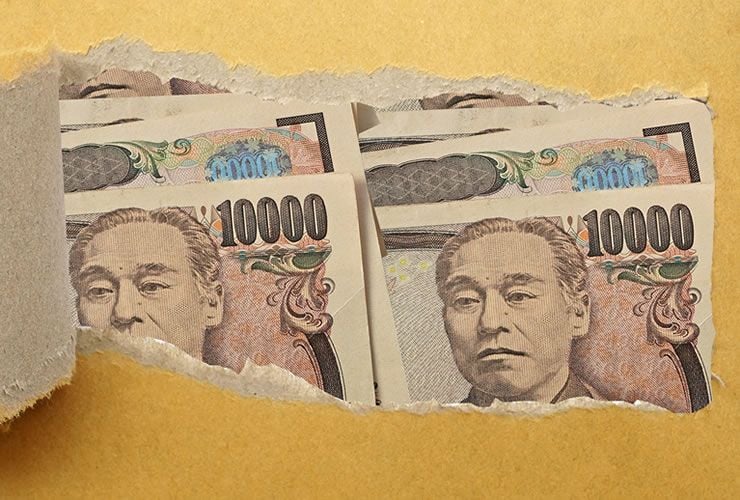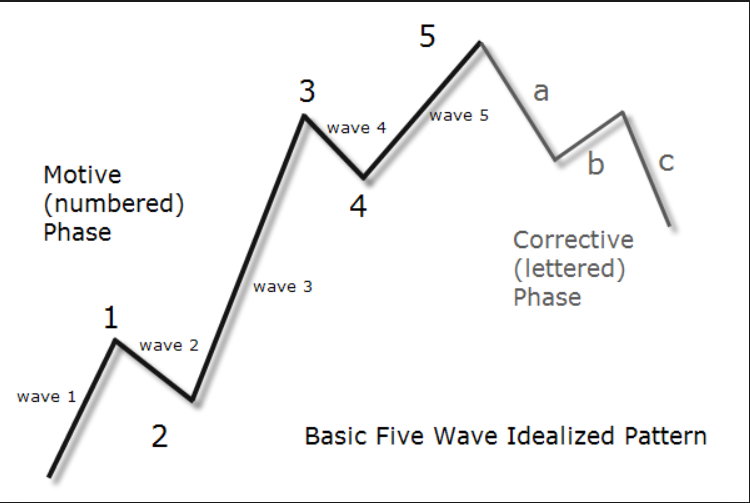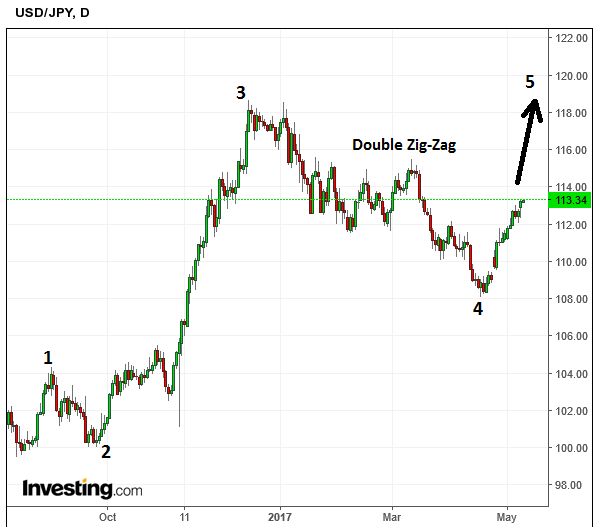USD/JPY is in an Uptrend, Elliot Wave Theory Gives Answers as to Whether it can Continue

More analysts have been flocking to the idea that USD/JPY is going to rise, but is it really such a hot prospect?
The first converts to the idea of USD strength versus the Yen were market technicians since the Dollar has been out of favour from the fundamental perspective due to the air-mattress-like deflation of the Trump trade.
The calls for a rally in the pair came from the fact that it started to resemble an incomplete text-book example of complex chart pattern, from a branch of technical analysis known as Elliot wave theory.
The theory, first discovered by a convalescing railroad accountant named Randolph Elliot, posits an underlying, repeating, wave cycle as the driving force behind financial markets.
The crux of the theory is that the market moves in five wave sequences, which repeat over and over.
Wave 1 is the initial move in the direction of the trend, wave 2 is a correction, wave 3 is a stronger move in the direction of the trend, wave 4 a shallow but often complex and lengthy correction and wave 5 is a final wave in the direction of the trend.

There then follows a larger correction before the whole five wave sequence begins again.
USD/JPY caught many Elliotician’s attention because it started exhibiting many of the classic characteristics of an Elliot wave in development.
This was particularly the case in March when its correction down from the 118 peak started to look like a wave 4.
As 2017 progressed wave four continued to correct back down, then in March it began to look complete.
Commerzbank’s Karen Jones commented on the fact in a note to clients on March 26, after it had fallen to 111:
“Please also note that the Elliot wave count on the daily chart suggests that this is the end of the down move.”
This suggested wave 5 was about to begin and move back up to the 118 highs, making USD/JPY a hot buy prospect.
Jones was a little early in her call but she had the right idea and after basing at 108 in late April, the pair gapped higher and started a new trend up to its current level in the 112s.
In its move down from the 118 December highs it had completed a rare and stunningly clear example of a wave 4 double zig-zag pattern, further deepening Elliotician’s conviction that the pattern was part of a broader five wave Elliot wave cycle.
If market technicians are right and the pair is in an Elliot wave, then it is currently on course to revisit the 118 December high, signalling 6 yen of potential upside.

The Macroeconomic Argument
The pair has not only gained endorsement from a technical perspective but also from a macroeconomic perspective too.
Most recently this was seen in the buy call issued by analyst Daniel P Hui of J P Morgan in a note to clients about commodity FX.
Hui argued that the Dollar could see a recovery when the Federal Reserve starts increasing interest rates in June, as is currently expected.
Further, that the Dollar is under-priced in relation to the differential between US interest rate expectations and counterpart expectations, which suggests an upside adjustment on the horizon to bring them more into line.
He argues interest rates are rising all over the globe except in Japan where the Bank of Japan (BOJ) is keeping monetary policy loose, and interest rates low.
This makes the Yen a prime candidate for the Dollar to appreciate against.
“We also add a long USD/JPY on the expectation of an ongoing rise in global yields (except for those anchored by the BOJ). Today’s strong US payrolls print, surprise in labor market tightness, following an on-track FOMC statement earlier this week reinforces the likelihood of a next June hike. While over 75% priced already in OIS markets, the broad USD continues to persistently lag rate-spreads (figure 4), suggesting that there is still a dollar upside skew even on a marginal Fed reprice,” said Hui in the note.

Clearly there do seem to be compelling arguments from both technical analysts, who have highlighted a textbook example of an Elliot wave pattern on USD/JPY, which is likely to complete with a wave 5 back up to the 118 highs, and from a fundamental perspective, in the form of a widening divergence between US and Japanese interest rates as the Fed gears up to hike rates in June whilst the BOJ continues to keep rates low.
Risk from Commodities
The main risk to the idea that USD/JPY will continue is fundamental and linked to commodities.
The Yen benefits when commodities fall in price as Japan has few natural resources of its own and is therefore heavily dependent on imported commodities and resources.
Lower commodity prices tend to help encourage a trade surplus and better terms of trade (the difference between the gross cost of imports versus exports), so if the current commodity rout continues the Yen is likely to benefit more than the Dollar, although whether that is enough to offset the rate differential as a primary driver for the pair is dependent and debatable - and probably unlikely, given Hui’s conclusions.
